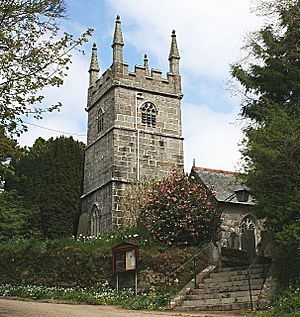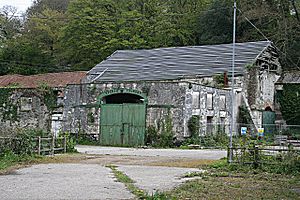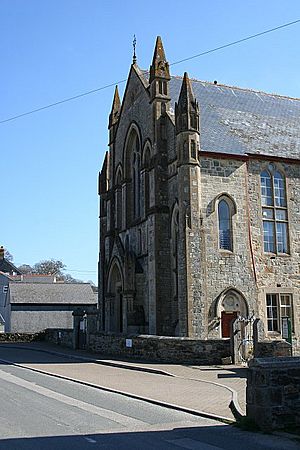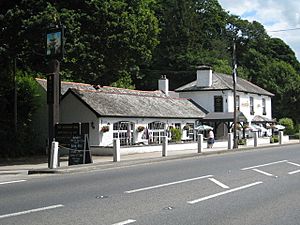Perranarworthal facts for kids
Perranarworthal (which in Cornish is Peran ar Wodhel) is a village and civil parish in Cornwall, England. It's located about 6.5 kilometers (4 miles) northwest of Falmouth. The village is also about 8 kilometers (5 miles) southwest of Truro. In 2011, about 1,496 people lived here.
A part of the parish is called Perran Wharf. It's next to the River Kennall, which flows into Restronguet Creek. This area once had wharves and a quay. Today, it's home to the historic Perran Foundry site, which now has new homes and workspaces. Other places in the parish are Perranwell and Perranwell Station. You can find Perranwell railway station on the Maritime Line.
Perranarworthal parish is surrounded by other parishes. To the north is Kea, to the east are Restronguet Creek and Mylor. To the south are St Gluvias and Stithians, and to the west is Gwennap.
Contents
A Look into History
The name Perranarworthal comes from the old Manor of Arworthal. Over time, its spelling changed many times. By the 1700s, maps showed "Perran Arworthal." This name means "St Piran's by the creek or estuary."
The Perran Iron Foundry
The Perran Iron Foundry was a very important and creative factory. At its busiest, it employed over 400 people! The Fox family from Falmouth, along with other Quaker business families, started the foundry in 1791. It was built where a tin smelting works used to be. Later, the Williams family also helped run the foundry. They eventually bought it in 1858.
The creek that served the factory started to fill with mud. Also, mining in Cornwall began to decline. Many barges would come to Perranwharf, bringing in timber from places like Scandinavia for the mines. They also imported coal, lime, and guano (a natural fertilizer).
The mining industry faced a big downturn in the 1870s. This badly affected Perran Foundry. It closed in March 1879, and 400 people lost their jobs. This caused a lot of hardship in the area. In April 1879, a local newspaper reported that a soup kitchen had been helping people since January. They had served 793 people and given out 1,240 quarts of soup.
The Perran Foundry property was very large, covering over 4 acres. It had many workshops, including a smithy and a hammermill. There was also a quay at Restronguet Creek where large ships could dock. The machinery and other items were sold at an auction in 1880.
Later, the buildings were used by the Edwards Brothers. They used them for milling grains, storing animal foods, and even dyeing cloth. Another waterwheel was added to the site. The site was used for different things until it finally closed in 1986.
In 2005, the owners planned to rebuild the site. They wanted to create new homes and workspaces. The first homes were finished in 2013, built from the old industrial buildings.
Interesting Buildings
The Norway Inn was first known as the Norway Hotel. It got its name from the ships from Norway that used to bring timber to Perran Wharf. This timber was mainly used in the mines.
Perran's Well was built in 1839. It provided fresh spring water from the local Bissoe aquifer. Merchants often stopped at the well when they traveled from Penryn harbor to Truro, which was a big trading center.
Tullimaar House is a large house built in the early 1800s. It was once the home of Sir William Golding (1911–1993). He was a famous writer who won the Nobel Prize.
Churches and Chapels
The Anglican parish church is dedicated to Saint Piran. The original church was built in the 1400s. It was rebuilt between 1881 and 1882. The old granite tower from the 1400s church is still there.
The foundation stone for the Wesleyan chapel was laid in 1879. The first service was held in February 1880. This chapel was designed to hold 600 people.
Cornish Wrestling
Perranarworthal has been a place for Cornish wrestling tournaments. These events were held at places like the Royal Oak near Perranwell Station.
Famous People
Many notable people have connections to Perranarworthal:
- Charles Fox and Barclay Fox were managers of the Perran Foundry.
- Saint Piran (or Perran) is the saint after whom Perran Foundry was named.
- The poet Jane Crewdson was born here.
- William Jory Henwood, a mining geologist, was born at Perran Wharf.
- William Lobb (1809–1864) was a plant collector. He brought the "monkey puzzle" tree (Araucaria araucana) and the giant redwood (Sequoiadendron giganteum) to England.
- William Golding, the famous novelist, lived in the village for eight years before he passed away in 1993.





